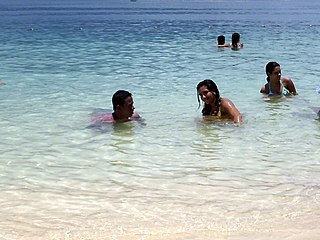Related Research Articles
Transport in Venezuela revolves around a system of highways and airports. Venezuela is connected to the world primarily via air and sea. In the south and east the Amazon rainforest region has limited cross-border transport; in the west, there is a mountainous border of over 1,375 miles (2,213 km) shared with Colombia. The Orinoco River is navigable by oceangoing vessels up to 400 km inland, and connects the major industrial city of Ciudad Guayana to the Atlantic Ocean.

Carabobo State is one of the 23 states of Venezuela, located in the north of the country, about two hours by car from Caracas. The capital city of this state is Valencia, which is also the country's main industrial center. The state's area is 4,369 km2 (1,687 sq mi) and as of the 2011 census, had a population of 2,245,744.

Hermógenes López was a Venezuelan soldier, farmer and acting president of his country between 1887 and 1888, after the resignation of General Antonio Guzmán Blanco who went into voluntary exile in Paris.

Municipalities of Venezuela are subdivisions of the States of Venezuela. There are 335 municipalities dividing the 23 states and the Capital District.

The State Railways Institution is a state-run organization of Venezuela that manages the railway systems of the country. Its headquarters are located in Caracas, Venezuela.

The Naguanagua municipality is one of the 14 municipalities (municipios) that makes up the Venezuelan state of Carabobo and, according to the 2011 census by the National Institute of Statistics of Venezuela, the municipality has a population of 157,437. The town of Naguanagua is the shire town of the Naguanagua Municipality. It forms part of the greater Valencia Metropolitan Area in Venezuela. It is in the valley of the Cabriales River at the base of Cerro El Café and the El Trigal Mountain. Valencia and Naguanagua form a continuous urban area. The highway that runs from the centre of Valencia towards Puerto Cabello passes through this community; Bolivar Avenue in Valencia becomes University Avenue in Naguanagua on the northern side of a traffic roundabout, or redoma.

The San Esteban National Park is located in Carabobo, Venezuela.
Pedro Carujo (1801–1836) was a Venezuelan military officer. He was one of the leaders in the Revolution of the Reforms of 1835.
John Carruthers was a British engineer and economic theorist from a Scottish literary family. He was born in Inverness, Inverness-shire, Scotland on 21 June 1836.

The Great Venezuela Railway was a 179-kilometre (111 mi) 3 ft 6 in railway from Caracas to Valencia. The railway was the longest in Venezuela. It proved difficult to recoup the initial investment and the railway became a notable cause of the Venezuelan crisis of 1902–1903. It fell into disrepair through the early 20th century and the last train ran in 1966.
Notitarde is a major newspaper printed in the Central Region of Venezuela. Based in the city of Valencia in Carabobo State, it also circulates in the United Aragua, Cojedes, the east coast of Falcón and Yaracuy, and with less traffic directed to Caracas. Despite its name, Notitarde is a morning newspaper. It has a daily circulation of 75,000 rising to 92,000 on Sundays.

The Plaza Bolívar is a square in Valencia, Venezuela. It occupies a central site, and is used for public meetings. Its origin was in the colonial period, when the city was laid out on a grid plan.(see note) Some buildings in the vicinity, such as the Cathedral date from the colonial period.

The Camoruco railway terminus in Valencia, Venezuela, is a rare survival of a 19th century railway station in the South America country. The building is also known as the Rectorado of the University of Carabobo. When the Puerto Cabello and Valencia railway closed in the 1950s, the station was transferred to the University of Carabobo which converted it for administrative use.

Aguas Calientes is the name of a river in Carabobo state.

Las Trincheras, also known as Las Trincheras de Aguas Calientes, is a locality near Valencia, Venezuela. It is noted for its hot springs, which feed into the Aguas Calientes River.

Bárbula is a locality in Naguanagua Municipality, Venezuela. It has the main campus of the University of Carabobo. The facilities include a palmetum, the Parque Universitario Palmetum.
Bárbula Tunnel is a railway tunnel under construction in Venezuela. It is between Las Trincheras and Naguanagua in Carabobo state. The tunnel has a length of 7.8 km (4.8 mi), which makes it the longest in South America. It takes its name from Bárbula, a locality in Naguanagua Municipality.
La Encrucijada, or La Encrucijada de Turmero, is a strategic road junction near Turmero, Venezuela. It is also planned to be a rail junction.
References
- 1 2 Chisholm, Hugh, ed. (1911). . Encyclopædia Britannica . Vol. 27 (11th ed.). Cambridge University Press. p. 846.
- 1 2 Carruthers, John (1889). "The Trincheras Steep Incline on the Puerto Cabello and Valencia Railway, Venezuela". Minutes of the Proceedings of the Institution of Civil Engineers. ICE Publishing. 96. doi:10.1680/imotp.1889.20790.
- ↑ Harrison, William Jerome (1889). . In Stephen, Leslie (ed.). Dictionary of National Biography . Vol. 18. London: Smith, Elder & Co. p. 153.
- ↑ "Obituary: John Carruthers". Minutes of the Proceedings of the Institution of Civil Engineers . 198. 1914. doi:10.1680/imotp.1914.16319.
- ↑ Morrison, A. "Map of Valencia" . Retrieved 14 April 2019.
- ↑ Puerto Cabello and Valencia Railway. Railways of South America.
- ↑ "Puerto Cabello-La Encrucijada Rail Line in Venezuela is 50% Complete". 2008. Retrieved 2019-04-27.
- ↑ Guthrie (2016). "Salini Impregilo beats targets - KHL Group". www.khl.com. Retrieved 2019-04-27.